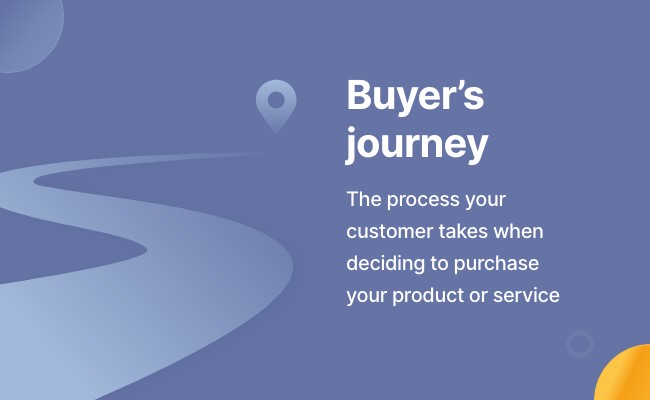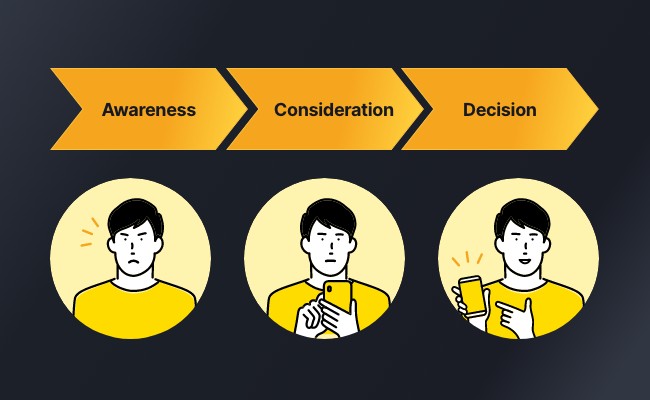Understanding your customers’ decision-making processes is vital to creating an effective sales funnel. This knowledge will make it possible for you to provide the right information to your leads at the right time, helping to convert them into paying customers. In this article, we are going to take an in-depth look at this decision-making process, known as the buyer’s journey.
What is the buyer’s journey?

A buyer’s journey is a document that describes the process one of your customers takes when deciding to purchase your product or service. It can be based on a real customer or an idealized customer known as a buyer persona. (Creating buyer personas is explained in our recent article, “How to Define Your Target Audience in Three Steps.”)
Despite how familiar we are with the concept of impulse-shopping, research shows that purchasing decisions are rarely made on a whim. Instead, they tend to follow three steps: awareness, consideration, and decision.
Take, for example, buying a home appliance like a refrigerator. First, you may notice your refrigerator is acting up. You research what could be wrong, weigh the costs of repairs vs. replacement, and ultimately decide it is time for a new refrigerator. You’ve just passed through the awareness step. Next, you go online to read reviews and/or head to the store to begin shopping. You examine the various features on all of the models and compare them with your own use case. What size fridge do you need? Do you need a touch screen and smart home connectivity? What about an ice maker or water filter? This is the consideration step.
Once you address your own usage needs and determine your budget, you are finally ready to make your purchase decision. Depending on the options being considered, this process can take anywhere from a few days to a few months. It can involve dozens of touchpoints as research is conducted and options are weighed. When you finally purchase your new refrigerator, you have completed your own buyer’s journey.
For your potential buyers, understanding how they make decisions during their journey is essential to creating an effective marketing and sales strategy. This understanding allows you to create effective marketing strategies that convert interested prospects to paying customers.
As we have just seen in the refrigerator example, there are three stages of the buyer’s journey:
-
Awareness: The buyer realizes they have a problem.
-
Consideration: The buyer defines their problem and researches options to solve it.
-
Decision: The buyer chooses a solution.
Timing is critical: where a customer is in this process will determine what they are looking for and what you need to be offering to ensure you are in the right place at the right time. Two of the most common mistakes in sales and marketing are waiting too long to deliver a sales pitch and being too aggressive early in the buying process. By determining the specific opportunities unique to each stage, you can ensure that you are appealing to potential buyers wherever they are in the process.
Why do I need a buyer’s journey for marketing?
In today’s marketing landscape, most of the buyer’s journey is online. For nearly every purchase, people turn to the internet to find answers and recommendations. This information is based almost entirely on other people’s experiences with products and services — not the promotional material provided by the businesses selling the products and services. This means you can’t afford to sit around and wait for prospective buyers to find you. Instead, you need to meet them where they are doing their research and making their decisions. You need to provide the information and answers they are looking for.
To achieve this, you need to get into the head of your potential customers and understand their experiences — their use cases, pain points, roadblocks, and opportunities. By doing this, you can create pieces of content, such as blog articles, social media posts, downloadable guides, webinars, or free-consultation campaigns that will resonate with them and facilitate their progress through the buying process. Furthermore, you can identify potential barriers and proactively remove them, ensuring a smoother sales process. Supplying your potential customers with advice and guidance, rather than attempting to force the process, helps to establish trust.
Why create unique content for each stage of the buyer’s journey?

The most important benefit of building your content around the stages of a buyer’s journey is that you have the ability to carefully nurture a prospect instead of forcing them into a sales conversation before they are ready, which could potentially scare them away for good. Often, potential buyers aren’t ready to make a purchasing decision on their first, second, or even third visit to your website or interaction with your brand. They’re typically researching or gathering more information for a problem they’ve only recently experienced. By offering the right types of content at the right time, you are able to tactfully guide them toward your brand rather than forcing them to make a decision before they’re ready.
Things to know before you start
As mentioned above and covered in depth in this article, you should have already created your buyer personas before starting to examine the buyer’s journey. You can’t create effective content for the buyer’s journey if you don’t first understand who your buyers are and what kinds of content will resonate with them.
Another key goal is ensuring your website and other channels are getting traffic. Whether you are generating traffic through organic search or paid leads, you should be proactive. Even the best messaging will be ignored if no one sees it. Similarly, you should be segmenting your visitors, meaning you should ensure that your analytics tracking, CRM, and other tools are set up to identify visitors and provide your sales and marketing teams with information such as what industry they are in, their role, and their pain points.
Now, let’s take a look at each of the three stages of the buyer’s journey: awareness, consideration, and decision.
What is the awareness stage of a buyer’s journey?
Awareness is the entry point into the sales funnel. Your potential customer is in the awareness stage when they have recognized a problem or need, and they are working to understand how to begin addressing it. Returning to our refrigerator analogy, there may suddenly be loud noises coming from it and water on the floor, or there is a persistent lack of space inside, or you may want to reduce your power bill. These represent three different problems (reliability, capacity, and efficiency) and the buyer will start their journey with three different sets of questions.
At this stage, you want your content to be providing answers to the questions these potential customers are asking. By addressing their pain points, you can establish yourself as a trusted expert who will guide them toward solving their problems.
What is the consideration stage of a buyer’s journey?
At this stage, potential buyers have identified the source of their issue as well as possible resolutions. They are considering various options, which include your product or service. However, the potential buyer is still in an educational mindset and looking for further information and answers in order to feel more confident about their purchase. The most important things for you to accomplish during this stage are building relationships and collecting contact information.
You should focus your content on what it’s like doing business with you — demos, data sheets, case studies, customer stories, etc. The consideration stage is when you are finally able to really communicate the value of your product or service. Your sales team should also be eager to reach out to qualified leads at this stage — qualified leads are well informed of their needs and ready to dive deeper into the solutions available.
What is the decision stage of a buyer’s journey?
During this final stage, your potential customer knows what their problem is and how to resolve it, has some options in mind, and is ready to make a purchase. They will be looking to speak with a sales representative, sign up for a trial offer, or request a quote. You should be offering an easy path for them to receive their consultation, product literature, and vendor comparisons.
At this stage, the most vital piece will be your sales team — the lead is qualified and you are ready to convert. Buyers in the decision stage are ready to click on your website CTAs and willing to read through your landing pages.
Creating your own buyer’s journey
It should be noted that specific details of a buyer’s journey will be unique to your own market and product or service. For example, B2C customers often spend little time in the middle of the funnel while B2B customers require more engagement and nurturing. A product that is $10 is usually a quicker decision than a service that is $2,000/month.
The best way to truly understand your buyers’ journey is to simply reach out to your current customers and ask them!
Ask your customers questions such as:
- What specific problem were you attempting to solve?
- What kind of solution were you looking for?
- What sources of information did you use?
- How credible and/or useful was the information you found?
- What were your next steps?
It’s important to create a buyer’s journey for each of your buyer personas. They should be reexamined and revised as often as the market and your offerings evolve. Ensure you and your sales and marketing teams are continually asking the above questions and working to publish and update your content accordingly.
If you do these things well, you will see a notable impact on your customer relationships. Customer engagement and loyalty will both increase if the buyer’s journey accurately reflects their experiences and answers their questions.
With buyer personas and buyer’s journeys, you are well on your way to creating a successful marketing strategy. You understand exactly who your ideal prospects are and how they will become your customers. The next step is to start developing content for them. This will include foundational documents that form the core of your marketing blueprint and outline what you offer your customers at all positions in your funnel. We will cover this in a future article. In the meantime, if you have any questions or feel like you could use some one-on-one guidance, feel free to reach out to one of our strategists.